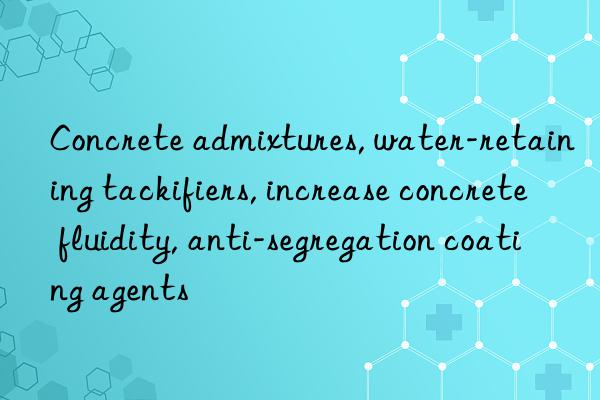
Although concrete admixtures can effectively improve the performance of concrete, they sometimes produce negative effects, especially when used improperly. Some abnormal phenomena will occur. Attention should be paid to this, and the causes and solutions should be found. The following causes and solutions are for readers’ reference.
Concrete admixtures water-retaining and thickening agents increase the fluidity of concrete
(1) Large slump loss of concrete
Cause: Admixtures have poor adaptability to cement or other raw materials; The dosage of admixtures is low; the cement or ambient temperature is high and the hydration rate is fast; the concrete mix ratio is improperly used.
Solution: Notify the admixture manufacturer to adjust the adaptability of the admixture to cement and replace unqualified raw materials; increase the amount of admixtures and mineral admixtures; adjust the concrete mix ratio.
(2) The setting time is too long
Cause: The amount of retarder is too large or the retarder dosage is not adjusted in time when the temperature drops suddenly, and the temperature and retarder are not adjusted according to the temperature during production. Adjust the amount of admixture according to the situation; the cement quality changes; the mineral admixture has quality problems; the mixing is uneven or the mixing time is too short, and the admixture is not evenly dispersed.
Solution: Adjust the amount of admixture according to weather conditions; notify the admixture supplier to reduce the amount of retarder or change the type of coagulant; replace cement or mineral admixtures; production is timely based on the temperature Change and adjust the mix ratio of concrete production.
(3) False setting
Cause: cement using anhydrite or industrial gypsum as the setting agent encounters cement containing calcium lignin or calcium sugar; the admixture contains sodium carbonate Early strength agent; triamine dosage exceeds 0.1%; cement temperature is too high; early strength agent dosage is too large.
Solution: Replace cement or admixtures; control the amount of triamine.
(4) Segregation and bleeding
Causes: Improper concrete mix ratio, low sand rate or cementitious material dosage; excessive admixture dosage, excessive slump ; The adaptability of cement and admixtures becomes better; there is an excess of carboxylates, phosphates or sugars in the retarder.
Solutions: Adjust the concrete mix ratio, increase the sand rate or increase the amount of cementitious materials; change the type of retarder, adjust the amount of admixtures; compound thickeners or air-entraining agents with admixtures and other water-retaining components.
(5) Poor workability
Causes: low sand rate or insufficient cementitious material dosage; low admixture dosage or poor water reduction effect.
Solution: Adjust the concrete mix ratio, increase the sand rate or increase the amount of cementitious materials; increase the amount of admixtures.
(6) Bottom-grabbing
Cause: The water-binder ratio is too low, the amount of water-reducing agent is too large, and the amount of cement is too large.
Solutions: Adjust the concrete mix ratio, increase the sand rate or increase the amount of mineral admixtures; add air-entraining agents; reduce the amount of admixtures, etc.
(7) Concrete efflorescence
Cause: Excessive dosage of inorganic salt early strength agent and antifreeze; poor early maintenance and rapid water evaporation.
Solution: Reduce the dosage of inorganic salt-containing additives, strengthen maintenance, and avoid early water loss.
Biological additives that can replace cellulose ethers
Product features: high temperature resistance, acid and alkali resistance, thickening and viscosity, improved pumpability and workability. Under the same conditions: prepare a 0.5% aqueous solution and measure the viscosity value at 12 rpm using Brookfield viscometer No. 3 spindle at room temperature, which is 2.5 times that of cellulose ether. </p

 微信扫一扫打赏
微信扫一扫打赏

